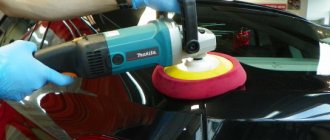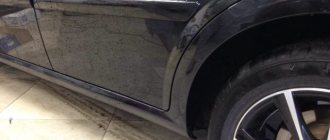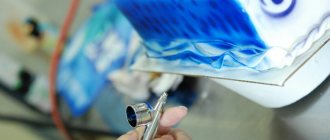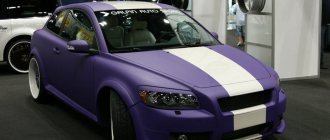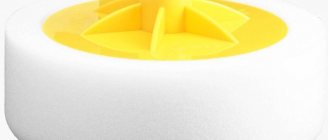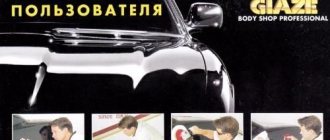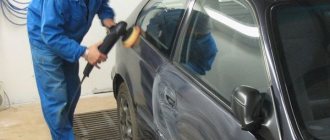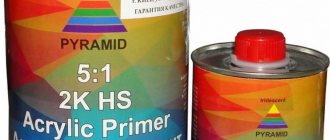Varnish for rear and headlights - treatment for polishing and tinting glass
Over time, headlights lose their attractive appearance and transmit light from bulbs worse. If the lighting deteriorates, you should first inspect the headlight lenses. If they are yellow, damaged or cloudy, the risk of getting into an accident increases. The damage listed above occurs due to the use of chemicals, mechanical stress or damage due to ultraviolet exposure.
Varnish for rear and headlights
If you don't take care of your lenses for a long time, they begin to change color and peel off. The plastic headlight deteriorates the fastest. To restore the original appearance, many motorists polish the optics. During the restoration process, you will need a headlight polishing varnish; its application is the final stage and plays the role of a protective layer for the material.
Protective varnish for headlights has a number of positive effects:
- prevents aging of headlights;
- prevents scratches and chips;
- gives a better aesthetic appearance;
- protects against dirt adhesion;
- allows you to save on replacing damaged headlights;
- reduces the influence of an aggressive environment.
History of pasta
GOI paste was developed in our country in the 30s of the 20th century by the State Optical Institute (GOI), specializing in the invention of grinding products. This is where the name came from - after the first letters of the institution. For over 100 years, this paste has been used to polish plastic, ceramics, steel and other metals, glass and stone.
GOI paste is a small bar, the color of which ranges from light green to dark green. It contains organic substances and chromium oxide (powder). It is used for polishing any type of surface, and several varieties are known, and a different type of paste is selected for each material. The product comes in fine, medium and coarse grain sizes. Previously, three types of GOI green paste were produced, differing in the content of abrasive particles:
- No. 4 – used for rough (initial) polishing.
- No. 3 – the surface acquires a matte shine, with no streaks observed.
- No. 1 or 2 – used for fine (final) polishing, adds gloss.
A surface polished with a fine paste acquires a mirror finish, a medium polished one gives an even shine, and a rough one removes scratches left after polishing. When choosing a paste for polishing headlights with your own hands, you need to take into account their original condition.
A variety of the product was previously produced in green bars in a solid state and in a paste state in boxes. The demand for both types is explained by effective polishing and affordable cost.
Today, the production of green paste is already prohibited because chromium oxide is a toxic carcinogen. Modern versions are red or white and are made from aluminum oxide. Red paste ensures faster polishing, while white paste ensures a smoother, higher-quality surface.
Types of varnish for headlights
All headlight varnishes are applied after polishing, but they differ in the strength of the beam refraction and, accordingly, in the different penetration of light.
Varnish for plastic headlights
Varnishes are divided into groups according to a number of criteria:
- by type of material. There is a varnish for plastic headlights (polycarbonates) and for glass processing;
- as intended. There are mainly 2 main groups: protective and toning. In the protective category, there is additionally a two-component headlight varnish and an aerosol;
- by composition. The composition of the substance is of greatest importance; professionals divide it into 3 types: two-component – varnish, which is sold complete with a solvent;
- urethane. It is completely transparent, comes in aerosol cans and can only be applied to a sanded headlight. It has high protective qualities and increases light transmission. The advantage is the ability to apply to installed headlights without dismantling them;
- acrylic. It has no color, but adds shine and hardens quickly. The disadvantage is the low ability to fill cracks and chips. Can be used for glass headlights, but is useless for plastic.
- H.S. The composition contains a lot of dry residue and a minimum of solvent. Gives a rich shine, acquires better characteristics when applied in 1.5 layers;
Aerosol varnish for car optics
Glass polish
And this composition is “ideal for glass, but can also be used for hard plastics, such as lamps.” The polish is in a convenient package, there are detailed instructions in Russian. But it took a long time to rub a napkin over the headlight to remove any remaining polish.
And still there are small scratches, abrasions and clouding - a slight matte coating. But the illumination increased by 30 lux.
Headlight polishes: Shine of burning eyes
Materials and tools
Polishing varnished headlights can be done using 2 main methods: with dismantling the optics and in the installed state directly on the car. The first option will require more time due to removal and installation work, but will allow you to restore the optics even with significant damage. There is no need to remove the headlight if the damage is subtle.
Regardless of the chosen direction, coating headlights with varnish after polishing will require the following materials and tools from the performer:
- napkins and rags;
- detergent;
- masking tape;
- solvent for degreasing the surface;
- grinding machine, it is better to equip it with a soft nozzle, this will speed up the process;
- abrasive paper marked 320, 600, 1000, 1200, 2000 and 2500;
- varnish If it is 2-component, you need to prepare a container in which the working solution will be prepared;
- A hairdryer will speed up the drying time.
Solvent "Solvent"
Cleaning from the inside
If external polishing does not give an ideal result, then try cleaning the inside of the headlights:
Do-it-yourself engine repair - major restoration and maintenance of an internal combustion engineDIY bumper: how to make a unique polymer bumper for a car at home (125 photos)
Do-it-yourself car painting - preparation for coating and the main stages of high-quality car painting (100 photos)
- Remove the headlights and check for major damage.
- Wash the headlights to remove external dirt and dust.
- Degrease the plastic surface.
- Polish until the surface of the headlight is smooth to the touch.
- Clean the surface from dust. Cover with a polish.
- Place the headlights on the car.
Fog lights can also be polished using all of the above methods.
Polishing requires careful execution and approximately an hour of time spent. Choose a polishing option depending on the degree of damage to the plastic or glass.
Be sure to use caution. Polish as needed, but the best option would be twice a year.
Polishing your headlights mainly improves your visibility on the road, which is key to your safety.
Polishing and protective varnish to improve light
Polishing headlights and varnishing significantly improves the penetration of light from the bulb and increases the efficiency of the optics. The technique has a requirement - the presence of smooth glass headlights. If an older type of glazing is installed, where the entire surface is covered with ribs, polishing will become impossible. It is recommended to simply replace the headlight, preferably with a smooth glass.
During the recovery procedures, the following should be performed:
- If you choose a permanent glass polishing method, you will have to cover the adjacent elements of the case with masking tape. It is necessary to provide high-quality protection so as not to disturb the paintwork of the car body.
- Use special pastes with abrasive additives; Delta Kits are a good option, but there is no fundamental difference. The abrasive is useful as a sandpaper to remove the top layer of damage.
- Wash the surface and wipe with a soft, dry, lint-free cloth. After drying, you need to coat the headlight with a degreaser, preferably using an inactive solvent. Before subsequent work, it is important to ensure protection against dust accumulation.
- You can proceed before applying polish. It is important to ensure the protection of the headlight, otherwise the coating will soon become damaged again.
- Varnishing is carried out in 2 or 3 layers, depending on how many times the manufacturer recommends coating the headlight.
Polishing and protective varnish for car optics
You can speed up polishing using various tools, but they are not mandatory. It is recommended to use higher quality materials during the procedure, which include two-component varnish. The process of preparing the working solution is described directly on the bottle or packaging. One of the best varieties are polyurethane-based varnishes; they provide increased hardness and reliability of glazing.
Trusted manufacturers
Common brands of headlight varnish include:
- Japanese Spot-On for professional use, supplied in 125 ml bottles and characterized by a high price (from 8.5 thousand rubles per set);
- Lens Clear from the Body company, intended for small workshops or do-it-yourself application (price from 700 rubles per bottle);
- Infinity from the manufacturer Delta Kits, designed for professional use. The price for the set is 800 rubles. (total capacity of bottles in the set is 15 ml).
Spot-On
Spot-On varnish from the manufacturer Kovax is a 2-component mixture. The reagents are mixed before application. The material is designed to restore the brightness and luminosity of polycarbonate headlights. The solution fills minor irregularities, but is not suitable for products with cracks on the surface of the diffuser. It is recommended to use a spray bottle for application; the shelf life of the mixture is 2 hours at an ambient temperature of +20°C. Dust that has got into the varnish must be removed using the proprietary Tolecut preparation and Kovax finishing paste.
Lens Clear
Lens Clear is supplied in a 400 ml aerosol can. The drug is ready for use. Before application, shake the container to mix the components. During processing, 2 layers are applied to protect the polycarbonate from ultraviolet radiation and sand. The manufacturer allows the use of varnish both in professional workshops and in garage conditions. The advantage of the material is rapid polymerization, which reduces the risk of dust sticking to the liquid varnish.
Infinity
Infinity Protective Varnish consists of 2 components that must be mixed before application. To ensure adhesion of the headlight surfaces, it is recommended to treat them with a special degreasing compound Delta Kits. To speed up the polymerization process, it is allowed to use heat from switched on low or high beam lamps or external sources. For additional protection against chipping, polyethylene armor is glued to the surface of the varnish.
Tinting the glass of your optics is a beautiful tuning effect
There is a way to improve the appearance of the headlights even more, they will not only have a shine, but also a special color. Tinting is used to enhance visual qualities. The headlights get a dramatic look and add tint to the headlights. The only drawback is the complexity of the procedure. To create a tint, you will need high-quality polishing and subsequent frosting of the glass. Only after preparation is the material applied.
The method of applying all types of tint is described in the instructions for the product or on the official resource. To determine the best tinting varnish with the optimal combination of price and quality, you can use customer reviews, but it is not recommended to buy cheap options. Regardless of your choice, you must adhere to the following application principle.
Car optics tinting
Clear Vue Glass Polish
According to the owners of the “turtle”, it is ideal for silicate glass, but is also suitable for hard transparent plastic. It's a pity they didn't provide a dispenser. Small scratches remained on the headlights, as did a whitish coating. The illumination increased, but only by 10 lux.
Glass polish
Declared manufacturer - NPKF Kolorit-B, Russia, commissioned by Sapphire LLC
Approximate price - 70 rubles.
Instructions for applying a tint coating to optics
If you compare the work of masters and amateurs, you will notice a significant difference in the quality of the final result. The reason is incorrect application or an error in following the rules. Carrying out the procedure yourself leads to risks of destructive effects of moisture or damage to integrity after abrasive stripping. You will have to repeat the polishing process again, only this time with dismantling the entire headlight.
Tinting can be carried out for front and rear optics. To obtain the best result, the most important principles should be used:
- high quality headlight painting becomes possible only after proper surface preparation;
- with careful and proper matting, as well as compliance with polishing rules, the destructive effect on the lens is reduced;
- matting is carried out using sandpaper with minimal grit, otherwise there is a risk of damage to the glass;
- the headlight should be allowed to dry on its own or wiped with a dry, lint-free cloth;
- The surface must be degreased before applying varnish;
- the coating is carried out in several layers, after each you need to wait for drying;
- the varnish is dried again, then the headlight is carefully examined for damage. If everything is in order, you can install the unit back.
Varnish for tinting lamps “Kudo”
An important condition for creating high-quality tinting is strict adherence to the manufacturer’s instructions and recommendations. When choosing the best varnish, many questions arise. Professionals prefer brands from Europe and America, the same applies to tinting for rear optics. The best options with positive reviews are Kudo, Kits, Exxo, Delta and Motip. The listed products are somewhat more expensive, but they cope with the task much better.
Instead of an epilogue
A car enthusiast should always remember that the use of non-specialized products, such as toothpaste, powder or micellar water, can only take place in emergency cases, because such products are not capable of providing a long-term effect. In addition, on a dirty road, the headlights, after such cleaning, will quickly return to their deplorable state. At the same time, professional cleaning of headlights in a workshop is not available to every driver due to its high cost. From this we can conclude that the best solution would be to independently use special automotive pastes for cleaning headlights. And the market analysis showed that among cleaning pastes there are more foreign samples, although the only domestic brand “3M” is ahead of them in all respects.
Recommendations from experts
If the buyer wants to make the most of his money and get the best result, he should:
- ensure maximum cleanliness of the room and good exhaust;
- carry out work only with personal protective equipment - gloves and a respirator;
- Before varnishing, glass should be especially carefully examined for the presence of sealant particles; bitumen is especially harmful. It is recommended to dry the glass surface in a thermostat set at 110 °C for 3 hours. When working with a construction hair dryer, this will prevent the appearance of cracks and boiling;
- It is better to avoid polishing pastes before varnishing plastic headlights. The plastic base reacts poorly to pastes and impairs adhesion to the varnish;
- To prevent the appearance of abrasions and stripes, you need to perform the procedure in several stages, gradually changing the direction. Each subsequent abrasive material is used for perpendicular grinding. With a sharp transition to a larger grain size of paper, clouding or a holographic effect appears;
- if the optics cannot be removed, for ease of operation it is better to raise the hood;
- two-component varnish should be diluted in small portions so that each part can be used for 5–10 minutes;
- To speed up the hardening of the varnish, you can warm up the headlight with a hairdryer for 10 minutes, only at a low temperature. The procedure is carried out only immediately after gluing;
- Do not wash or treat headlights for 1 day after application;
- To enhance the protection of the varnish, it is necessary to apply an anti-gravel film on top.
What to pay attention to
The main reasons that the optical characteristics of headlights have decreased are as follows:
- Natural aging, during which glass and plastic, especially low quality ones, begin to lose light transmission under the influence of ultraviolet rays. A number of optical systems, predominantly made in China, lose a third of the beam power after just a short mileage.
- Scratches that appear from stones, sand from cars in front, or rising from the road. This “sandblasting” acts as an abrasive mixture, causing a web of cracks that impair the optical properties of the headlight lens.
- Chemical reagents, often used in winter after snow melts with splashes of dirt, fall on the headlights, causing them to start working dimmer.
The question seems natural: how can we make sure that external factors, reagents, scratches, have less impact? One of the most popular and effective methods, according to car owners, is tinting with an “armored” film. It is able to prevent the appearance of most scratches and prevents the penetration of aggressive chemicals. You can apply it either by trusting a car service specialist or by yourself. However, not all modern popular car models allow such protection. Before applying the film, you should ask whether the manufacturer of the car or optics allows the use of such “reservation”.
If the light from reflectors and street lamps has already fallen and it’s too late to “drink Borjomi”, only car cosmetics can help. But before using it, you should assess the degree of damage to the surface to be treated. If the surface of a glass or plastic cap has only cloudiness or small scratches, then they can be leveled at home, using specialized products. It will be difficult to eliminate medium-depth chips with your own hands. And without tools such as a sander or electric drill, it will take a long time. It is quite possible that a number of cases will require the intervention of professionals with all the ensuing financial expenses. More severe chips and cracks will require replacing the headlight altogether.
How to choose the best polish
First of all, it is necessary to assess what type of surface is to be treated, which will help to avoid mistakes when choosing a paste or polish. They can be glass or plastic, so working with them has its own nuances. For example, abrasives are contraindicated for glass surfaces since any more or less large fraction can cause deep cracks. Plastic ones are afraid of high temperatures, which is why using a polishing tool, especially at high speeds, is prohibited. In addition, factory-made products have protective, resuscitating, and combined properties. So the first ones protect surfaces from ultraviolet rays, the second ones restore them, and the third ones respectively combine the two effects mentioned above. In addition, when selecting products, you should take into account the recommendations of the car manufacturer. Most often, car optics receive surface damage after a trip outside the city. Therefore, if you make frequent trips out of town, you should have polishing liquid in your car. To make the bottle easy to place in the car, the selection criteria will be weight, packaging volume, ergonomics of packaging.
What are the budget types of scratch removal?
Any purchase of branded polishes can be quite an expensive operation. Even if you order them online in an online store. It is not surprising that lately, homemade, improvised methods for leveling damage have become increasingly popular. There are quite a few car models to which such methods can be applied. These are both old stamps and those released quite recently.
The most affordable option would be to polish the surface with toothpaste. Of course, the paste will not give a strong effect, but it will be suitable as a pre-sale means of improving appearance. The second most popular method is the use of GOI paste, which has been known to almost everyone since the times of the USSR. Its advantages are availability, ease of operation, versatility of use (suitable for both plastic and glass polishing). GOI paste has a hard, bright green structure, which is determined by certain features of application and grinding. Working with paste is carried out in the following steps:
- Coating the surface to be processed, the grinding wheel, sandpaper, with GOI composition.
- Sanding the part. If it is plastic, grinding takes place manually or at low speeds of a drill.
- Then the surface is wiped with a damp cloth to clean the glass or plastic from GOI residues, or if necessary, washed.
- Steps 1-3 are repeated using abrasive material with a lower number. Usually they start with No. 4 and end with No. 1.
Homemade grinding, in addition to paste and polish, will require a napkin or rag, water, it is better to use a spray bottle, abrasive, masking tape, which is used to cover the space near the headlight.
Which company is better to choose a product?
Car stores are replete with car cosmetics; the range is almost equivalent to the women's department. The guarantee of high-quality products that meet all stated requirements is their branded origin. The best manufacturers that have proven themselves are:
- Sapphire is a domestic manufacturer of budget category liquids, according to whose orders other companies often create mixtures.
- Runway is an American company whose production facilities are located in China and Russia. The combination of components from the USA, high quality control and local production allows us to make the company's products the best in the price/quality segment.
- Abro is another American manufacturer of components for auto painting, sealants, lubricants, and automotive oils. The company's products have earned the best reviews from domestic car enthusiasts, and it has representative offices in all federal districts of Russia.
- Sonax is a European manufacturer with more than a century of history in the production of grinding products. The company produces cosmetics for cars, developed on the basis of its own technologies for the care of tires, windshields, and body parts.
- Turtle Wax is a company whose auto products, mastics, and body wax-containing polishes are known all over the world. Therefore, British or Spanish citizenship is often attributed to “turtle wax,” as the company name is translated. In fact, the company is American, founded in the middle of the last century.
Unfortunately, even a purchase through a branded car store does not guarantee the presence of counterfeit products. To avoid this, when purchasing, you should carefully look at the label of the tube or bottle. The text on it should be clearly readable, without double letters. The description of the composition of the container should also be clearly visible without the use of optical instruments. In addition, step-by-step instructions are usually supplied on the label or along with the container, which is an indicator of the branded manufacture of the product.
Let's sum it up
When comparing good liquids for abrasive stripping and paint processing, it is recommended to use products from the manufacturer 3M. For polishing, the company's assortment includes effective solutions that meet the standard quality-to-price ratio and also provide consistently good results. The paste allows you to restore headlights even with severe scratches and chips.
Polishing mixtures are sold in containers of various capacities, each accompanied by the manufacturer's instructions. It is best to select a varnish based on individual tasks and the assortment in stores nearby.
PlastX, Clear Plastic Cleaner & Polish
The composition is designed specifically for cleaning and polishing transparent plastic. The packaging is convenient, there is a dispenser, but for some reason there was no Russian annotation.
The polish is easy to apply and rub in. If the haze is minor, it can be removed and the illumination improved by 30 lux.
Headlight Lens Restoration Kit , art. 09135
Declared manufacturer - Permatex Inc., USA
Approximate price - 730 rubles.
Causes of cloudiness
Yellow headlights, if this is not a special type of tuning, cause sympathetic glances from drivers and problems with traffic police inspectors. The requirements for the quality of road lighting are high, and if the lights have dimmed significantly, this is a direct violation of traffic regulations.
The cases are made of glass and plastic. Optics manufacturers refuse to use glass for many reasons:
- expensive;
- glass blocks are heavy;
- do not require frequent replacement and are not profitable to produce.
It takes more than one year for headlights made of glass to become cloudy. Plastic cases are 70% lighter and 560% softer than glass. It is beneficial for manufacturers to use plastic, because car owners have to spend more time and money on maintaining them. Reasons why optics units turned yellow or cloudy:
- Systematic impact of gravel, which hits the lights at speed.
- Using light bulbs of unspecified power: the protective coating in the plastic peels off from the inside.
- Dust accumulates in microscopic cracks.
- Overheating during polishing causes the plastic to become cloudy and dark.
If the lights have lost their transparency, you can restore the optics with varnish, after polishing the surface.
